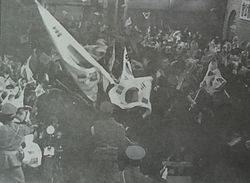
Back حركة الأول من مارس Arabic Moviment Primer de Març Catalan Bewegung des ersten März German Κίνημα της 1ης Μαρτίου Greek Movimiento Primero de Marzo Spanish Martxoaren 1eko mugimendua Basque جنبش اول مارس Persian Maaliskuun 1. päivän liike Finnish Mouvement du 1er mars French Pergerakan 1 Maret ID
You can help expand this article with text translated from the corresponding article in Korean. (February 2024) Click [show] for important translation instructions.
|
| March 1st Movement | |
|---|---|
 | |
| Official name | March 1st Movement Samil Movement |
| Also called | Man-se Demonstrations |
| Significance | Marks one of the first public displays of Korean resistance during the Japanese occupation of Korea |
| Observances | March 1, national holiday in South Korea since 1949 |
| Date | March 1, 1919 |
| March 1st Movement | |
| Hangul | 3·1 운동 |
|---|---|
| Hanja | |
| Revised Romanization | Samil Undong |
| McCune–Reischauer | Samil Undong |
The March 1st Movement, also known as the Sam-il (3-1) Movement (Korean: 3·1 운동), was a significant protest movement in early 1919 by Korean people that called for independence from Imperial Japan and a stop to the forced assimilation into Japanese culture. It is also sometimes referred to as the Man-se Demonstrations (Korean: 만세운동; Hanja: 萬歲運動; lit. Ten-thousand Year Movement). It is remembered as one of the earliest and largest protest movements for Korean independence, and remembered as a catalyst for future independence activities. Thirty-three Korean cultural and religious leaders issued a proclamation, supported by thousands of students and civilians in Seoul. There were over 1,000 demonstrations in many other cities. These were brutally suppressed, with Korean historian Park Eun-sik reporting about 7,500 killed and 16,000 wounded, and 46,000 arrested.
Korea eventually achieved independence decades later after the surrender of Japan at the end of World War II. Today, March 1st is celebrated as a national holiday in South Korea, but not in North Korea.[1]
- ^ Kim, Hyeon-gyeong (1 March 1997). "In North Korea, March 1st is distortedly taught as being caused by the Kim Il-sung family". MBC News. Retrieved 8 March 2023.
© MMXXIII Rich X Search. We shall prevail. All rights reserved. Rich X Search